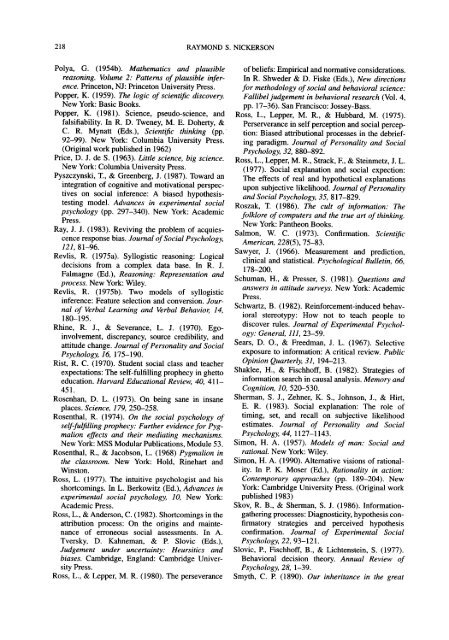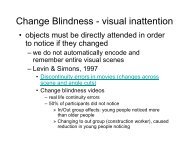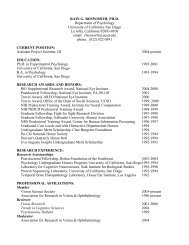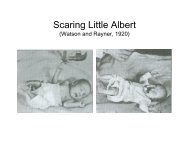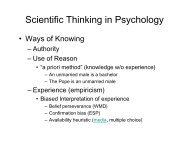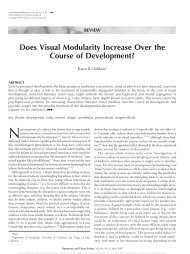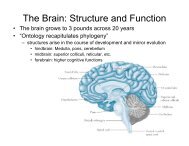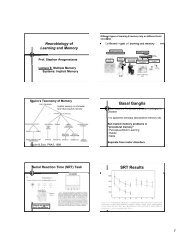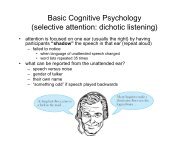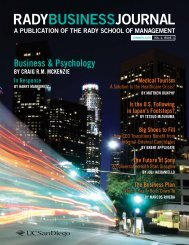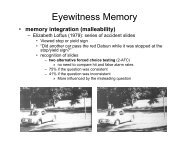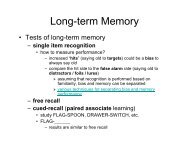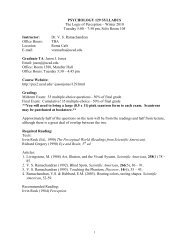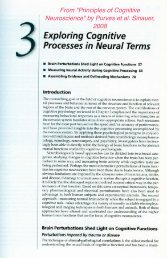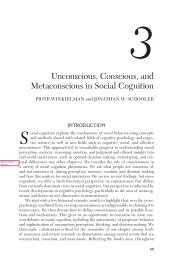Confirmation Bias: A Ubiquitous Phenomenon in Many Guises
Confirmation Bias: A Ubiquitous Phenomenon in Many Guises
Confirmation Bias: A Ubiquitous Phenomenon in Many Guises
You also want an ePaper? Increase the reach of your titles
YUMPU automatically turns print PDFs into web optimized ePapers that Google loves.
218 RAYMOND S. NICKERSON<br />
Polya, G. (1954b). Mathematics and plausible<br />
reason<strong>in</strong>g. Volume 2: Patterns of plausible <strong>in</strong>ference.<br />
Pr<strong>in</strong>ceton, NJ: Pr<strong>in</strong>ceton University Press.<br />
Popper, K. (1959). The logic of scientific discovery.<br />
New York: Basic Books.<br />
Popper, K. (1981). Science, pseudo-science, and<br />
falsifiability. In R. D. Tweney, M. E. Doherty, &<br />
C. R. Mynatt (Eds.), Scientific th<strong>in</strong>k<strong>in</strong>g (pp.<br />
92-99). New York: Columbia University Press.<br />
(Orig<strong>in</strong>al work published <strong>in</strong> 1962)<br />
Price, D. J. de S. (1963). Little science, big science.<br />
New York: Columbia University Press.<br />
Pyszczynski, T., & Greenberg, J. (1987). Toward an<br />
<strong>in</strong>tegration of cognitive and motivational perspectives<br />
on social <strong>in</strong>ference: A biased hypothesistest<strong>in</strong>g<br />
model. Advances <strong>in</strong> experimental social<br />
psychology (pp. 297-340). New York: Academic<br />
Press.<br />
Ray, J. J. (1983). Reviv<strong>in</strong>g the problem of acquiescence<br />
response bias. Journal of Social Psychology,<br />
121, 81-96.<br />
Revlis, R. (1975a). Syllogistic reason<strong>in</strong>g: Logical<br />
decisions from a complex data base. In R. J.<br />
Falmagne (Ed.), Reason<strong>in</strong>g: Representation and<br />
process. New York: Wiley.<br />
Revlis, R. (1975b). Two models of syllogistic<br />
<strong>in</strong>ference: Feature selection and conversion. Journal<br />
of Verbal Learn<strong>in</strong>g and Verbal Behavior, 14,<br />
180-195.<br />
Rh<strong>in</strong>e, R. J., & Severance, L. J. (1970). Ego<strong>in</strong>volvement,<br />
discrepancy, source credibility, and<br />
attitude change. Journal of Personality and Social<br />
Psychology, 16, 175-190.<br />
Rist, R. C. (1970). Student social class and teacher<br />
expectations: The self-fulfill<strong>in</strong>g prophecy <strong>in</strong> ghetto<br />
education. Harvard Educational Review, 40, 411-<br />
451.<br />
Rosenhan, D. L. (1973). On be<strong>in</strong>g sane <strong>in</strong> <strong>in</strong>sane<br />
places. Science, 179, 250-258.<br />
Rosenthal, R. (1974). On the social psychology of<br />
self-fulfill<strong>in</strong>g prophecy: Further evidence for Pygmalion<br />
effects and their mediat<strong>in</strong>g mechanisms.<br />
New York: MSS Modular Publications, Module 53.<br />
Rosenthal, R., & Jacobson, L. (1968) Pygmalion <strong>in</strong><br />
the classroom. New York: Hold, R<strong>in</strong>ehart and<br />
W<strong>in</strong>ston.<br />
Ross, L. (1977). The <strong>in</strong>tuitive psychologist and his<br />
shortcom<strong>in</strong>gs. In L. Berkowitz (Ed.), Advances <strong>in</strong><br />
experimental social psychology, 10, New York:<br />
Academic Press.<br />
Ross, L., & Anderson, C. (1982). Shortcom<strong>in</strong>gs <strong>in</strong> the<br />
attribution process: On the orig<strong>in</strong>s and ma<strong>in</strong>tenance<br />
of erroneous social assessments. In A.<br />
Tversky, D. Kahneman, & P. Slovic (Eds.),<br />
Judgement under uncerta<strong>in</strong>ty: Heursitics and<br />
biases. Cambridge, England: Cambridge University<br />
Press.<br />
Ross, L., & Lepper, M. R. (1980). The perseverance<br />
of beliefs: Empirical and normative considerations.<br />
In R. Shweder & D. Fiske (Eds.), New directions<br />
for methodology of social and behavioral science:<br />
Fallibel judgement <strong>in</strong> behavioral research (Vol. 4,<br />
pp. 17-36). San Francisco: Jossey-Bass.<br />
Ross, L., Lepper, M. R., & Hubbard, M. (1975).<br />
Perserverance <strong>in</strong> self perception and social perception:<br />
<strong>Bias</strong>ed attributional processes <strong>in</strong> the debrief<strong>in</strong>g<br />
paradigm. Journal of Personality and Social<br />
Psychology, 32, 880-892.<br />
Ross, L., Lepper, M. R., Strack, F, & Ste<strong>in</strong>metz, J. L.<br />
(1977). Social explanation and social expection:<br />
The effects of real and hypothetical explanations<br />
upon subjective likelihood. Journal of Personality<br />
and Social Psychology, 35, 817-829.<br />
Roszak, T. (1986). The cult of <strong>in</strong>formation: The<br />
folklore of computers and the true art of th<strong>in</strong>k<strong>in</strong>g.<br />
New York: Pantheon Books.<br />
Salmon, W. C. (1973). <strong>Confirmation</strong>. Scientific<br />
American, 228(5), 75-83.<br />
Sawyer, J. (1966). Measurement and prediction,<br />
cl<strong>in</strong>ical and statistical. Psychological Bullet<strong>in</strong>, 66,<br />
178-200.<br />
Schuman, H., & Presser, S. (1981). Questions and<br />
answers <strong>in</strong> attitude surveys. New York: Academic<br />
Press.<br />
Schwartz, B. (1982). Re<strong>in</strong>forcement-<strong>in</strong>duced behavioral<br />
stereotypy: How not to teach people to<br />
discover rules. Journal of Experimental Psychology:<br />
General, 111, 23-59.<br />
Sears, D. O., & Freedman, J. L. (1967). Selective<br />
exposure to <strong>in</strong>formation: A critical review. Public<br />
Op<strong>in</strong>ion Quarterly, 31, 194-213.<br />
Shaklee, H., & Fischhoff, B. (1982). Strategies of<br />
<strong>in</strong>formation search <strong>in</strong> causal analysis. Memory and<br />
Cognition, 10, 520-530.<br />
Sherman, S. J., Zehner, K. S., Johnson, J., & Hirt,<br />
E. R. (1983). Social explanation: The role of<br />
tim<strong>in</strong>g, set, and recall on subjective likelihood<br />
estimates. Journal of Personality and Social<br />
Psychology, 44, 1127-1143.<br />
Simon, H. A. (1957). Models of man: Social and<br />
rational. New York: Wiley.<br />
Simon, H. A. (1990). Alternative visions of rationality.<br />
In P. K. Moser (Ed.), Rationality <strong>in</strong> action:<br />
Contemporary approaches (pp. 189-204). New<br />
York: Cambridge University Press. (Orig<strong>in</strong>al work<br />
published 1983)<br />
Skov, R. B., & Sherman, S. J. (1986). Informationgather<strong>in</strong>g<br />
processes: Diagnosticity, hypothesis confirmatory<br />
strategies and perceived hypothesis<br />
confirmation. Journal of Experimental Social<br />
Psychology, 22, 93-121.<br />
Slovic, P., Fischhoff, B., & Lichtenste<strong>in</strong>, S. (1977).<br />
Behavioral decision theory. Annual Review of<br />
Psychology, 28, 1-39.<br />
Smyth, C. P. (1890). Our <strong>in</strong>heritance <strong>in</strong> the great


